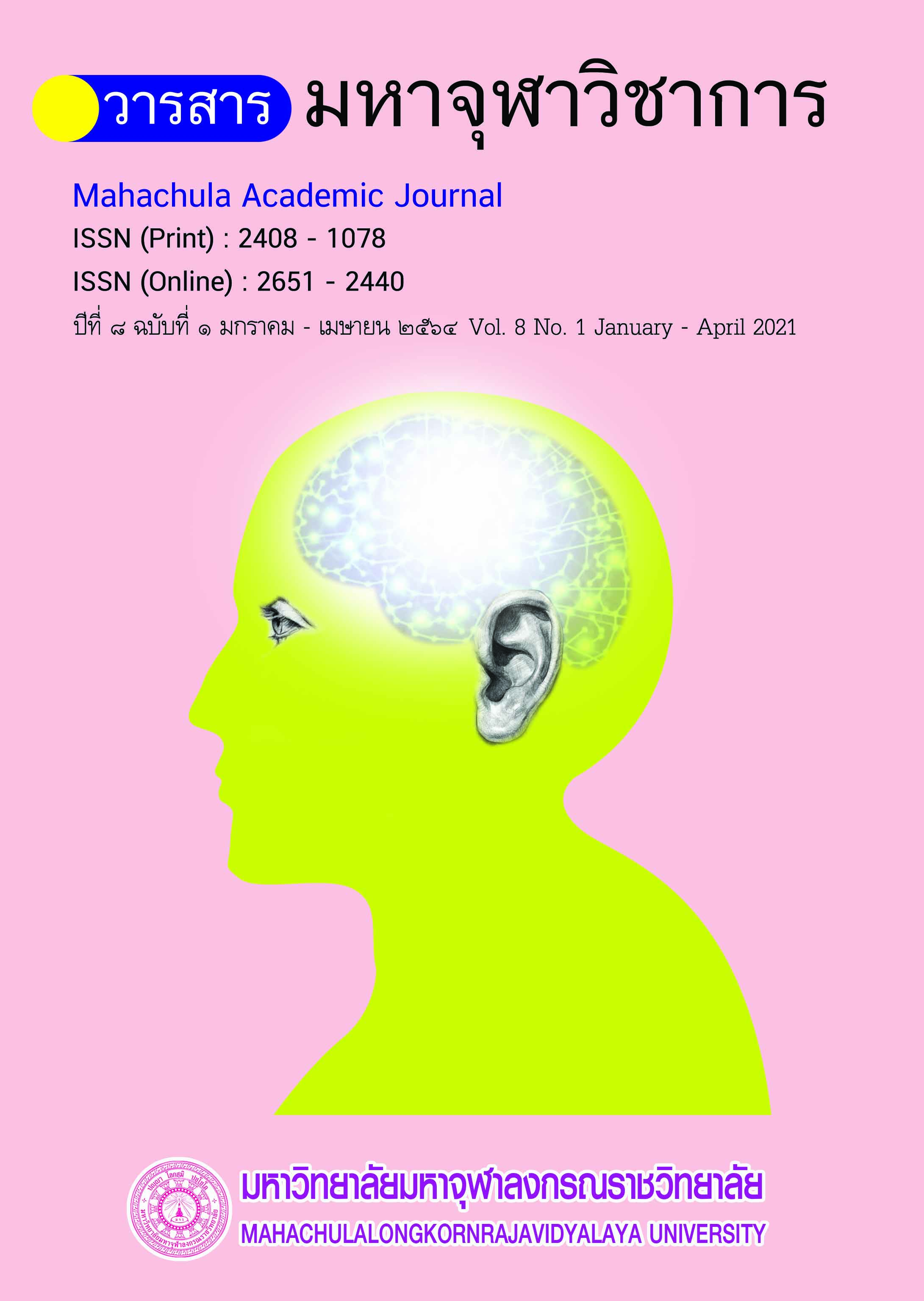Cultivation of New Generation Youth with Viriyaparamita Practice
Main Article Content
Abstract
The objectives of this thesis were as follows; (1) to study the cultivation of the new generation youth, (2) to study the cultivation of the new generation youth with Viriyaparamita Practice, and (3) to analyze the value of the cultivation of the new generation youth with Viriyaparamita Practice. The thesis was the documentary qualitative research work focused on documentaries, studies mainly on the Tipitaka, relating documentaries and relevant researches together with the interviews of the related experts. All of the data were then analyzed by content analysis, classified into system, concluded and presented in descriptive analyzed by content analysis, classified into system, summarized and presented in descriptive analysis. The results of research were found as follows; (1) The cultivation of a new youth was the development of the quality
of life for the new generation of youth to accomplish their goals by practicing more diligence and discipline leading to success in life in the terms of both education and work. (2)How to cultivate the New Gen Youth with Viriyaparamita is to gradually and arduously make them focused on what they undertaken and their values. New Gen Youth has to make effort to achieve their goal of life. The moral principles for this consist of
4 Itthipada (How to success), 4 Sammappadhana (efforts), 5 Indriya (spiritual Faculties) 10 Paramitas (Perfection) and 7 Bojjhangas (Factors of Enlightenment) (3) The analytical results for the value of the cultivation of the new generation youth with Viriyaparamita Practice were as follows: 1) the value of creating a nation was to make the nation for sustainable progress, 2) The value of achieving life goals was to make the life achieve its goals and 3) the value of being a model for next generations was a role model behavior
for the new young generation in order to grow in the world of evolution and having the practical wisdom in daily life.
Article Details
References
ปรีดา ปัญญาจันทร์. นิทานคุณธรรมจากพระราชดำรัส : ความเพียร เล่ม ๓. กรุงเทพมหานคร: สำนักพิมพ์แพรวเพื่อนเด็ก, ๒๕๕๗.
พร มลิทอง. อิทธิบาท ๔ หนังสือสอนพระพุทธศาสนาแก่เด็ก. กรุงเทพมหานคร: โรงพิมพ์มหาจุฬาลงกรณ์ราชวิทยาลัย, ๒๕๕๑.
พระมหาบุญเลี้ยง เตชพโล (บุตรตะเคียน). “มโนทัศเรื่องตบะในพระพุทธศาสนา”. วิทยานิพนธ์ศาสนศาสตรมหาบัณฑิต. บัณฑิตวิทยาลัย: มหามกุฏราชวิทยาลัย, ๒๕๔๔.
พระมหาปรีชา ปภงฺคโร (มั่นเขตกิจ). “มโนทัศน์เรื่องความเพียรในพระพุทธศาสนาเถรวาท”. วิทยานิพนธ์พุทธศาสตรมหาบัณฑิต. บัณฑิตวิทยาลัย: มหาวิทยาลัยมหามกุฏราชวิทยาลัย, ๒๕๕๑.
พระมหาสมศักดิ์ ญาณโพธิ์ และธานี สุวรรณประทีป. “แนวทางการเสริมสร้างวิริยบารมีแก่เยาวชนไทยในสังคมปัจจุบัน”. วารสาร มจร บาฬีศึกษาพุทธโฆสปริทรรศน์. ปีที่ ๓ ฉบับที่ ๑ (มกราคม - มิถุนายน ๒๕๖๐) : ๖๙.
พระสมุห์วัชรินทร์ ถาวโร (ผาสุข). “ศึกษาการบําเพ็ญเพียรของพระโสณโกฬิวิสเถระในคัมภีร์พระพุทธศาสนา”. วิทยานิพนธ์พุทธศาสตรมหาบัณฑิต. บัณฑิตวิทยาลัย: มหาวิทยาลัยมหาจุฬาลงกรณราชวิทยาลัย, ๒๕๔๔.
พระสุทัศน์ สุทสฺสโน (วงค์สถาน). “การนำหลักอิทธิบาท ๔ ไปใช้ในการศึกษาเล่าเรียนของนักเรียนโรงเรียนสามัคคีวิทยาทาน อำเภอเมืองเชียงใหม่ จังหวัดเชียงใหม่”. วิทยานิพนธ์พุทธศาสตรมหาบัณฑิต. บัณฑิตวิทยาลัย: มหาวิทยาลัยมหามกุฏราชวิทยาลัย, ๒๕๕๕.
สุวรรณี เลื่องยศลือชากุล. “การศึกษาความเพียรของพระโสณาเถรีที่ปรากฏในคัมภีร์พระพุทธศาสนา”. วิทยานิพนธ์พุทธศาสตรมหาบัณฑิต. บัณฑิตวิทยาลัย: มหาวิทยาลัยมหาจุฬาลงกรณราชวิทยาลัย, ๒๕๕๑.
อนงค์ ชีระพันธุ์. “ปัญหาที่มีผลต่อพฤติกรรมทางเพศของวัยรุ่นในโรงเรียนมัธยมศึกษาสังกัดกรมสามัญศึกษา จังหวัดขอนแก่น”. วิทยานิพนธ์ศิลปศาสตรมหาบัณฑิต. บัณฑิตวิทยาลัย: มหาวิทยาลัยขอนแก่น, ๒๕๔๔.


